-
Car Reviews
- Car News
-
Car Comparisons
Latest comparisons
- Chasing Deals
Beyond its hype-generating design, the N Vision 74 is a lighthouse technical showcase of Hyundai’s engineering machine
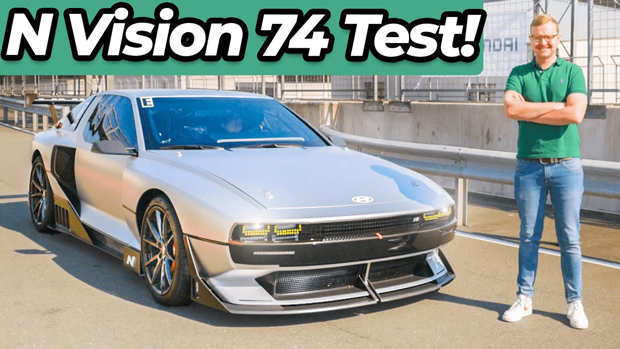
Before asking what the 2023 Hyundai N Vision 74 concept is like to drive, it’s worth spending a moment to question why this electric-hydrogen supercar exists in the first place. A technical marvel worth the best part of $1 million, the ’74’ is a monument to what the South Korean conglomerate is now capable of.
Having invested very heavily in researching, developing and successfully launching its N Performance sports-car division, Hyundai is now investigating two related strands of engineering: how to retain N’s signature “corner rascal” dynamics in the coming age of ultra-heavy electric vehicles, but also how to go about building a flagship sports car that isn’t too expensive.
That’s where excitement levels tap the brakes on the stunning N Vision 74, feted at its static reveal in Busan, South Korea, in June, and equally as impressive in daylight at the Bilster Berg test track in Germany where Chasing Cars was among a very small cohort to drive the fully operational “rolling lab” prototype.
Speaking with Chasing Cars, Hyundai executive technical advisor Albert Biermann indicated that while the N Vision 74 was technically possible to build, and could even exist as a Hyundai, the expense of a production version would see it step outside the logical bounds of a Hyundai vehicle. Think supercar money – half a million dollars.
It might be a Genesis in future, or the novel hydrogen fuel-cell, battery-electric hybrid system could be further developed and amortised across a range of future Hyundai and Kia performance cars.
Or, as we hope occurs, the N Vision 74’s sublime body, signed off by chief designer Sangyup Lee as a retro-futuristic development of Giugiaro’s Hyundai Pony Coupe and Delorean designs, might be used for a future Hyundai Group model – but perhaps without the ultra-expensive hybrid setup.
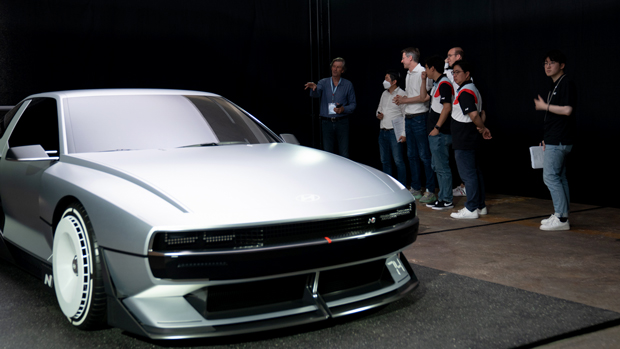
But as it sits, this is a hella-cool vision of zero-emission supercar tech, way beyond anything Ferrari, Lamborghini or McLaren will admit to developing. Even if the N Vision 74 were pure battery-electric – as a hypothesised production version could be – it would still be visually stunning and mechanically capable, based around dual rear motors: one per wheel, allowing for incredibly precise traction control…and superb drifting prowess.
Neatly packaged aboard the N Vision 74 are two 4.2kg hydrogen tanks, a fuel-cell stack that makes 85kW on its own, a 63kWh-usable lithium-ion battery, and the dual motors rated at about 250kW/450Nm apiece.
Total outputs at full-chat are in the vicinity of 500kW (670 horsepower) and 900Nm. Refuelling the hydrogen tanks is a five-minute affairs while the battery can be topped off using an ultra-rapid charger in about 18 minutes.
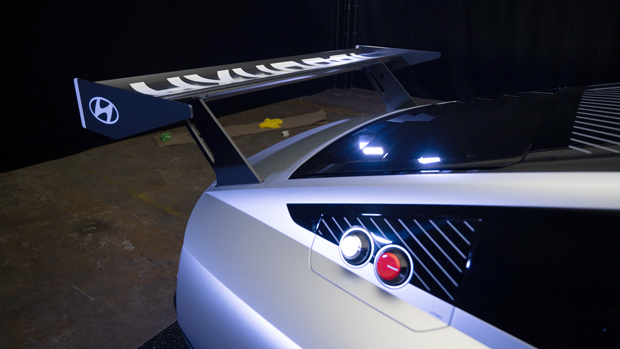
This vehicle is actually series-parallel hybrid: it can run on power supplied by the hydrogen fuel-cell alone at up to 85kW of power or so – fine for getting around in urban spaces. Demand more punch from the motors and the battery is called upon to tip in, allowing the headline 500kW peak number.
In reality, across our four laps of Bilster Berg, we found it very difficult to discern which of the power sources was contributing what – a testament to the slickly engineered blend, but also the fact that both power sources are ultimately contributing electric power. Without the rumble of a petrol engine kicking in, this is a highly refined hybrid concept.
While the integration of the two power sources is refined, though, the N Vision 74’s half-finished cabin isn’t. The design is smart and presentable, based around a retro-bezel interpretation of the company’s 12.3-inch display found other products, but the unique central spine with climate and multimedia buttons is new – and it looks great. Expect to see that in other Hyundai cars soon.
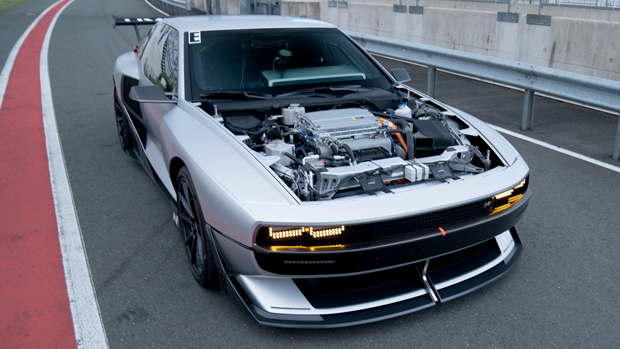
But most of the cabin is dedicated to track driving and tuning. Huge bucket seats supporting multi-point restraints are mounted extremely low atop a floor with no carpeting or insulation – and while this is an electric vehicle, the natural sounds of the motors are deliberately not damped or muffled out, meaning the car screams to life as soon as you tap the throttle (but is dead silent at rest).
Noise is going to be one of the next frontiers of EV development. While some manufacturers – namely Tesla – prefer the strong, silent approach, others recognise a demand from some buyers for auditory feedback reflecting pace and load in the vehicle. Most applications so far are purely synthetic with varying believability (Porsche Taycan Sport Sound, BMW’s Hans Zimmer-composed i4 soundtrack), but Hyundai is seeking to pursue something more real.
In the N Vision 74, the operational sounds of the motors are allowed to be heard. They’re still a little soft, and a future approach is to amplify these sounds further to build engagement – but it’s honestly a nicer experience than driving in total silence, wondering why the horizon is coming at us sooner.
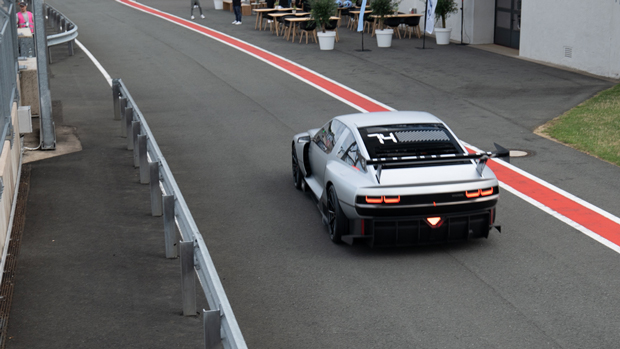
With all this tech aboard, it wasn’t possible to make the near-five metre-long N Vision 74 light. It’s 2500kg, and while the focussed suspension and sticky tyres contribute significantly to agility, there’s no avoiding a sensation of inertia – but once you get the N Vision 74 turned in, it can carry significant speed through corners. The steering is heavily weighted, like “muscle car” was on the front page of the brief for dynamic tuning of this rolling lab.
There’s also a lot of mass waiting to go sideways. In our test, stability control remained officially on, but the car’s track driving mode clearly provides significant leeway in yaw. Even moderate throttle applications mid-corner channel significant torque to the relevantly outside wheel’s motor through a central brain.
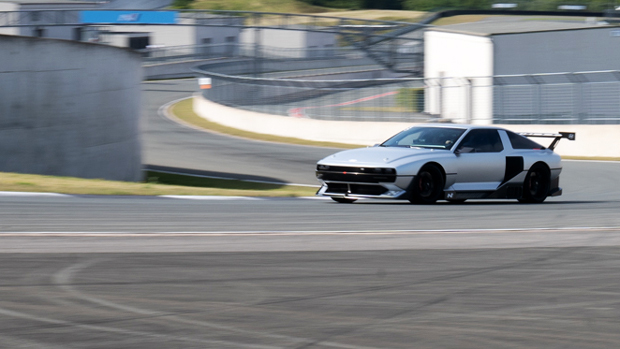
But the dual motors at the rear afford precise control by your right boot of the sideways, and there is exceptional forward punch out of corners when you’re plotting sensible lines. The motors seem to start to tail off in aggression beyond 150km/h on the race track, but until that point there is huge forward thrust.
In the car we drove, regenerative braking was triggered by application of the brake pedal, as in a Porsche Taycan, rather than simply by lifting off the throttle. This speaks to a growing schism within EV-world: should braking be a discrete task, or merely the absence of acceleration? At the moment we tend to prefer the former.
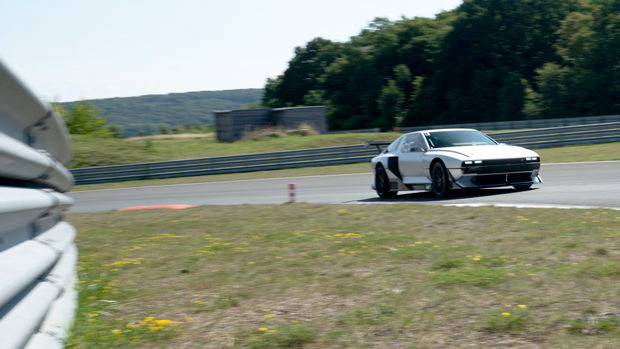
So, as a large, heavy-set but very muscular hybrid supercar focussed on track-work, the N Vision 74 is a compelling proposition – at least over four initial laps. Cutting 800kg out of the car would undoubtedly do wonders for the cornering dynamics, which are merely good instead of great in current form – but with all these components aboard, that is a huge ask. Still, it is interesting that Hyundai N’s first battery-electric vehicle will weigh a relatively light 2000kg…
What will become of the N Vision 74? There are whispers of a tour of high-brow design events for the vehicle. It is shrouded in secrecy about whether the N Vision 74 we drove is a one-off: there’s definitely a static vehicle, but there may be a second “rolling lab” in this shape waiting in the wings to pick up development. Or it may be that the job is done here, and Hyundai’s hydrogen-electric hybrid supercar concept will be parked for a later decision.
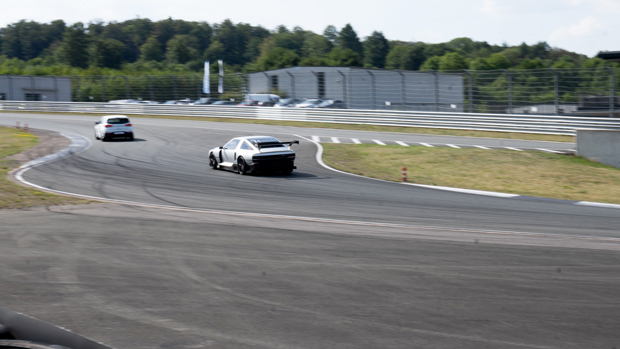
For our part, we think the tech is worth developing further – if it can genuinely be predicted that hydrogen will have consumer applications and infrastructure in a decade from now. If that isn’t going to happen, being honest, the vehicle could to be converted to an exclusively battery-electric approach. But the way Hyundai sees it, hydrogen and battery-electric cars alike will each be a significant piece of the mix in 2030–creating space for a bespoke sports car just like this.
| Month reviewed | August 2022 | |
| Location of test | Bilster Berg Test Track, Germany | |
| Base price (MRLP) | $500,000 (estimated) | |
| As-tested price (MRLP) | ||
| Options fitted | Matte grey paint | |
About Chasing cars
Chasing Cars reviews are 100% independent.
Because we are powered by Budget Direct Insurance, we don’t receive advertising or sales revenue from car manufacturers.
We’re truly independent – giving you Australia’s best car reviews.
The estimate provided does not take into account your personal circumstances but is intended to give a general indication of the cost of insurance, in order to obtain a complete quote, please visit www.budgetdirect.com.au. Estimate includes 15%^ online discount.
^Conditions Apply
Budget Direct Insurance arranged by Auto & General Services Pty Ltd ACN 003 617 909(AGS) AFSL 241 411, for and on behalf of the insurer, Auto & General Insurance Company Limited(ABN 42 111 586 353, AFSL 285 571).Because we don’t know your financial needs, we can’t advise you if this insurance will suit you. You should consider your needs and the Product Disclosure Statement before making a decision to buy insurance. Terms and conditions apply.
Indicative quote based on assumptions including postcode , 40 year old male with no offences, licence suspensions or claims in the last 5 years, a NCD Rating 1 and no younger drivers listed. White car, driven up to 10,000kms a year, unfinanced, with no modifications, factory options and/or non-standard accessories, private use only and garaged at night.
^Online Discounts Terms & Conditions
1. Discounts apply to the premium paid for a new Budget Direct Gold Comprehensive Car Insurance, Third Party Property Only or Third Party Property, Fire & Theft Insurance policy initiated online on or after 29 March 2017. Discounts do not apply to optional Roadside Assistance.
2. Discounts do not apply to any renewal offer of insurance.
3. Discounts only apply to the insurance portion of the premium. Discounts are applied before government charges, taxes, levies and fees, including instalment processing fees (as applicable). The full extent of discounts may therefore be impacted.
4. We reserve the right to change the offer without notice.